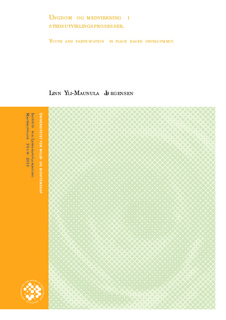| dc.contributor.author | Jørgensen, Linn Yli-Maunula | |
| dc.date.accessioned | 2013-07-12T09:25:49Z | |
| dc.date.available | 2013-07-12T09:25:49Z | |
| dc.date.issued | 2013-07-12 | |
| dc.identifier.uri | http://hdl.handle.net/11250/188367 | |
| dc.description.abstract | Medvirkning i stedsutvikling er et tema som stadig tilegnes større oppmerksomhet. En behandler ofte medvirkning fra «barn og unge» sammen, uten at det nødvendigvis er hensiktsmessig at disse gruppene settes i samme bås. I denne oppgaven fokuseres det spesifikt på ungdomsbefolkningen og deres medvirkning i stedsutviklingsprosesser, og det legges vekt på hva planleggere får igjen for ungdommenes medvirkning. Temaet belyses gjennom et kombinert litteratur- og eksempelstudie. I kapittel 2 presenteres litteraturdelen. Her gjøres det rede for ungdommers medvirkning i planlegging i en historisk kontekst. Litteraturens argumenter for hvorfor planleggere trenger ungdommers bidrag legges frem. Hva ungdommene kan bidra med og hvordan vi kan benytte oss av resultatene presenteres videre. Jeg gjør et eksempelstudie i form av et eksperiment med en metode jeg kaller Lynch-Stadkjensle-analyse. Dette gjøres både for å bidra med flere erfaringer med medvirkningsbaserte analyseverktøy på denne spesifikke brukergruppen, og for å se hvilke bidrag ungdommene som deltar kan og vil gi og hvordan en eksempelvis kan benytte seg av bidragene i stedsutvikling i ettertid. Gjennomføringen av eksperimentet presenteres i kapittel 3 og resultatene finnes i kapittel 4. Litteratur- og eksempelstudiet viser at det finnes sterke og holdbare argumenter for hvorfor vi trenger ungdommers bidrag i stedsutviklingen. Ungdom er en av de viktigste brukergrupper av våre uterom og sitter på unik kunnskap om deres opplevelse og bruk av stedet. Deres bidrag vil kunne være med å forankre planene i brukergruppen samtidig som planene forankres i lover og regler og bygger opp om nasjonale mål og føringer. Mange ungdommer har både kreative og løsningsorienterte evner som kan hjelpe planleggere i arbeidet med å øke stedets attraktivitet både for brukergruppen og for resten av befolkningen. Hva ungdommene kan bidra med, og hvordan planleggere kan benytte seg av resultatene fra deres medvirkning avhenger av mange faktorer vi gjør før, under og etter en medvirkningsprosess. En vesentlig del av god stedsutvikling ligger derfor i å ha kunnskap om hvilke faktorer som er av betydning før vi går i gang med omfattende medvirkningsprosesser. The focus on participation in place based development is constantly increasing. Children and youth are in this context often put into the same category, despite the fact that these two groups often need very different approaches. This thesis focus lies specifically on youth and their participation in place based development. The thesis emphasizes on what planners achieve by letting the youth participate. The topic is addressed through a combination of a literature- and case study. The literature section is presented in Chapter 2. It provides a historic view on young people’s participation in planning. Arguments from the literature on why planners need youth’s contributes, what contributions the youth gives, and how planners should process and use these contributions are presented further on in Chapter 2. I’ve done a case study in the form of an experiment with a new method I call Lynch-Stadkjensle-analysis (Lynch- Sense of place-analysis). This is done both to provide more experiences with participation-based analysis specifically on youth population, and to see what contributions the youth can and are willing to provide, and also to give an example on how to take advantage of the contribution in place based development. The completion of the experiment is presented in Chapter 3, and the results can be found in Chapter 4. The study shows that there are strong and durable arguments regarding why planners need youth to participate in place based development. Young people are one of the main users of our outdoor spaces and possess unique knowledge about their experience and use of the site. Their participation can contribute to anchor the plans in its youth population at the same time as the plans get anchored in laws and regulations and reinforcen national goals and guidelines. A lot of the youth population are both creative and have solution-oriented qualities and capabilities that can help planners in their
efforts to increase the site’s attractiveness for the youths in addition to the rest of the population. What the youth can contribute with, and how the planners can use the results from their participation depends on factors we do before, during and after a participatory process. An essential part of successful place based development is therefore to have knowledge about which factors are important before we embark on extensive participation. | no_NO |
| dc.language.iso | nob | no_NO |
| dc.publisher | Norwegian University of Life Sciences, Ås | |
| dc.subject | Landskapsarkitektur | no_NO |
| dc.subject | Landscape architecture | no_NO |
| dc.subject | Medvirkning | no_NO |
| dc.subject | Participation | no_NO |
| dc.subject | Ungdom | no_NO |
| dc.subject | Youth | no_NO |
| dc.subject | Stedsutvikling | no_NO |
| dc.subject | Place based development | no_NO |
| dc.title | Ungdom og medvirkning i stedsutviklingsprosesser. | no_NO |
| dc.title.alternative | Youth and participation in place based development. | no_NO |
| dc.type | Master thesis | no_NO |
| dc.subject.nsi | VDP::Social science: 200::Urbanism and physical planning: 230::Landscape planning: 236 | no_NO |
| dc.subject.nsi | VDP::Humanities: 000::Architecture and design: 140::Landscape architecture: 147 | no_NO |
| dc.source.pagenumber | 167 | no_NO |
